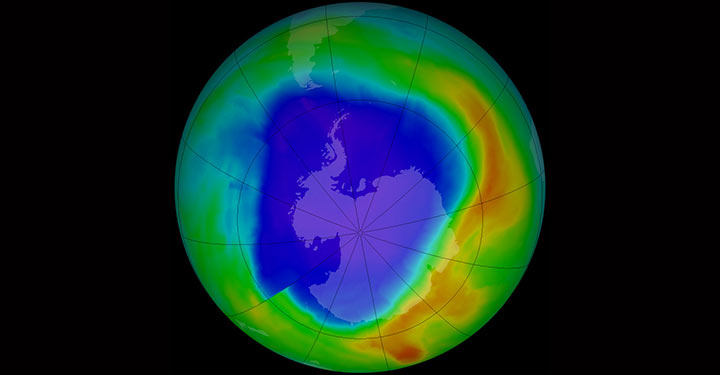Professor Lucy Carpenter, from our Department of Chemistry, played a key role in the new scientific assessment of the Earth’s ozone layer, which will inform government policies across the globe.
The report, issued by the World Meteorological Organization (WMO) and the United Nations Environment Programme (UNEP), analysed the impact on the ozone layer of concerted international action since the adoption of the Montreal Protocol.
The Montreal Protocol
The Montreal Protocol is an international treaty that was agreed in the 1987 to try to protect the ozone layer and phase out numerous substances that are responsible for ozone depletion.
The study shows that total column ozone has remained relatively steady over the last decade and shows recent signs towards recovery, following the phase-out of ozone damaging substances including chlorofluorocarbons (CFCs) and halons, once found in aerosol sprays, fridges and insulation foam.
The 2014 assessment concludes that actions taken under the Montreal Protocol have led to decreases in the amount of ozone-depleting substances (ODSs) - with expected return of the ozone layer toward 1980 levels by mid-century in mid latitudes and the Arctic, and somewhat later in the Antarctic.
However, while the Montreal Protocol and its Amendments and adjustments have made large contributions toward reducing global greenhouse gas emissions, these could be significantly offset in the future by projected emissions of hydrofluorocarbons (HFCs) currently used as ODS replacements.
Professor Carpenter said: "The report – the first comprehensive update in four years – analyses the impact on the Earth’s protective ozone layer of concerted international action since the adoption of the Montreal Protocol in 1987. It also assesses the implications of the phase out of ozone-depleting substances on efforts to address climate change."
Professor Carpenter’s chapter of the report concentrated on ozone-depleting substances and other gases of interest to the Montreal Protocol. Some of the work cited in this section of the assessment was carried out by researchers based at York.
York’s involvement
Professor Carpenter said: "Research at the University of York has contributed to the assessment by determining trends and abundances of ODSs and their substitutes in the atmosphere and by assessing the contributions of natural compounds to ozone depletion."
The assessment was co-sponsored by NASA, the National Oceanic and Atmospheric Administration (NOAA) and the European Commission. It is written and reviewed by leading experts in the international atmospheric sciences community at the request of the Parties to the UN Montreal Protocol and contains the most up-to-date understanding of ozone depletion. The assessment will guide policymakers as they strengthen the original provisions of the Montreal Protocol.
Professor Lucy Carpenter acted as a Lead Author of Chapter 1: Update on ODSs and Other Gases of Interest to the Montreal Protocol of the Scientific Assessment of Ozone Depletion: 2014, which is due to be released shortly, and of The Assessment for Decision-Makers, a summary document of the assessment which was released on 10 September.
The text of this article is licensed under a Creative Commons Licence. You're free to republish it, as long as you link back to this page and credit us.





